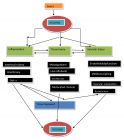Abstract
Research Article
Compliance of hypertensive patients with antihypertensive drug therapy at the Renaissance Hospital of N’Djamena, Chad
Adam Ahamat Ali*, Guillaume Mahamat Abderraman*, Zeinabou Maiga Moussa Tondi and Hissein Ali Mahamat
Published: 23 October, 2019 | Volume 3 - Issue 1 | Pages: 047-051
Introduction: High blood pressure is a major cardiovascular risk factor. In hypertension, non-compliance is frequent. The objective of this work is to evaluate the therapeutic observances and to identify the predictive factors of poor compliances in Chadian hypertensive patients.
Patients and Methods: It was a prospective cross-sectional study over a six-month period from January 15 to July 15, 2019. This was performed in the outpatient Cardiology and Nephrology units at the Renaissance Hospital of N’Djamena. We included all follow-up patients who had hypertension who consulted during the study period. However, dialysis patients and children were excluded from this study. The parameters studied were demographic characteristics, economic and therapeutic data and the rate of therapeutic compliance.
Results: Eighty-seven patients were included. The average age was 50 years old. The sex ratio was 2.5. Sixty-seven percent (n = 58) of the patients were from urban areas. The predominant cardiovascular risk factors were smoking in 25% (n = 22) and diabetes in 23% (n = 20). Hypertension was uncontrolled in 76% (n = 66) patients. Adherence was poor in 66% (n = 57) of patients. The monthly cost of treatment was respectively 10,000 and 20,000 FCFA in 52% (n = 45) of cases. Combination therapy was observed in 70% of cases (n = 61) and 56% (n = 49) of patients had more than one drug intake. The adherence rate was 93% (n = 28) in the urban population (p < 0.001). All patients (n = 30) who were observing their treatment were educated (p < 0.001). The adherence rate was 20% (n = 6) in patients who had a monthly income less than 100,000 FCFA (p = 0.004). The adherence rate was 60% (n = 18) when the monthly cost was less than FCFA 10,000 (p = 0.003). The adherence rate was 77% (n = 23) in patients receiving monotherapy (p < 0.001).
Conclusion: This study showed a low level of adherence in Chadian hypertensive patients. The complexity and cost of antihypertensive therapy, poor knowledge of hypertension, and ignorance of its severity have been the main factors of poor compliance.
Read Full Article HTML DOI: 10.29328/journal.ach.1001019 Cite this Article Read Full Article PDF
Keywords:
Arterial hypertension; Therapeutic observance; N’Djamena-Chad
References
- Chamontin B, Poggi L, Lang T, Menard J, Chevalier H, et al. Prevalence, treatment, and control of hypertension in the French population: data from a survey on high blood pressure in general practice, 1994. Am J Hypertens. 1998; 11: 759-762. PubMed: https://www.ncbi.nlm.nih.gov/pubmed/9657642
- Osterberg L, Blaschke T. Adherence to medication. N Engl J Med. 2005; 353: 487-497. PubMed: https://www.ncbi.nlm.nih.gov/pubmed/16079372
- Ho PM, Bryson CL, Rumsfeld JS. Medication adherence: its importance in cardiovascular outcomes. Circulation. 2009; 119: 3028-3035. PubMed: https://www.ncbi.nlm.nih.gov/pubmed/19528344
- Piquet V, Cedrashi C, Desmeules J. Prescription médicamenteuse: les attentes des patients. Med Et Hyg. 2000; 58: 814-817.
- Giraud M. Observance thérapeutique et rôle infirmier. Rev De l’Infirmiére. 1999; 52: 48-49.
- Bertrand Ed. Le Dogme et réalité; la pathologie cardiovasculaire en pays sous développé cardiol Trop. 1988; 14: 95-96.
- Cohen A. Cardiologie et pathologie vasculaire Ed. ESTEM. Paris. 1997: 188-192.
- Chowdhury R, Khan H, Heydon E, Shroufi A, Fahimi S, et al. Adherence to cardiovascular therapy: a meta-analysis of prevalence and clinical consequences. Eur Heart J. 2013; 34: 2940–2948. PubMed: https://www.ncbi.nlm.nih.gov/pubmed/23907142
- Chobanian AV, Bakris GL, Black HR, Cushman WC, Green LA, et al. The seventh report of the Joint National Committee on prevention, detection, evaluation and treatment of high blood pressure. JAMA. 2003; 289: 2560-2572. PubMed: https://www.ncbi.nlm.nih.gov/pubmed/12748199
- Girerd X, Hanon O, Anangnostopoulos K, Cirepek L, Mourad JJ, et al. Evaluation de l'observance du traitement antihypertenseur par un questionnaire : mise au point et utilisation dans un service spécialisé. Presse Med. 2001; 30: 1044-1048.
- Williams B, Mancia G, Spierin GW, Agabiti Rosei E, Azizi M, et al. 2018 ESC/ESH Guidelines for the management of arterial hypertension. Eur Heart J. 2018; 39: 3021-3104. PubMed: https://www.ncbi.nlm.nih.gov/pubmed/30165516
- Claxton A, Cramer JA, Pierce C. A systematic review of associations between dose regime and medication compliance. Clin Ther. 2001; 23: 1296-1310. PubMed: https://www.ncbi.nlm.nih.gov/pubmed/11558866
- Iskedjian M, Einarson TR, Mackeigan LD, Shear N, Addis A, et al. Relation between daily frequency and adherence to antihypertensive pharmacotherapy: evidence from a meta-analysis. Clin Ther. 2002; 24: 302-316. PubMed: https://www.ncbi.nlm.nih.gov/pubmed/11911560
- Konin C, Adoh M, Coulibaly I, Kramoh E, Safou M, et al. Observance thérapeutique et ses facteurs chez l’hypertendu noir africain. Archives des maladies du coeur et des vaisseaux Vol 100, N° 8 - août 2007; 630-634.
- Ghozzi H, Kassis M, Hakim A, Sahnoun Z, Abderrahmen A, et al. Observance médicamenteuse chez un échantillon d'hypertendus dans la région de Sfax (Tunisie). Ann Cardiol Angeiol. 2010; 59: 131-137.
- Stéphane IM, Nsitou BM, Loumouamou M, Kimbally-Kaky G, Nkoua JL. L’observance médicamenteuse et ses facteurs dans un groupe d’hypertendus congolais. Pan Afr Med J. 2013; 15: 121.
- Gallup G Jr, Cotugno HE. Preferences and practices of americans andtheir physicians in antihypertensive therapy. Am J Med. 1986; 81: 20-24. PubMed: https://www.ncbi.nlm.nih.gov/pubmed/2879454
- Adoubi KA, Diby KF, Nguetta R, Yangni-Angate KH, Adoh AM. Facteurs de la mauvaise observance thérapeutique de l'hypertendu en Côte d'Ivoire. Rev Int Sc Med. 2006; 8: 18-22.
- Pio M, Baragou S, Afassinou Y, Pessinaba S, Atta B, et al. Observance thérapeutique de l’hypertension artérielle et ses facteurs dans le service de cardiologie du CHU Tokoin de Lomé. Pan Afr Med J. 2013; 14: 48.
- Eisen SA, Miller DK, Woodwards RS, Spitznagel E, Przybeck TR. The Effect of Prescribed Daily Dose Frequency on Patient Medication Compliance. Arch Intern Med. 1990; 150: 1881-1884. PubMed: https://www.ncbi.nlm.nih.gov/pubmed/2102668
- Saounatsou M, Patsi O, Fasoi G, Stylianou M, Kavga A, et al. The influence of the hypertensive patients education in compliance with their medication. Public Health Nurs. 2001; 18: 436-442. PubMed: https://www.ncbi.nlm.nih.gov/pubmed/11737812
- Campbell NR, Lackland DT, Lisheng L, Zhang XH, Nilsson PM, et al. The World Hypertension League: where now and where to in salt reduction. Cardiovasc Diagn Ther. 2015; 5: 238-242. PubMed: https://www.ncbi.nlm.nih.gov/pubmed/26090335
- Pio M, Baragou S, Afassinou Y, Pessinaba S, Atta B, et al. Observance thérapeutique de l'hypertension artérielle et ses facteurs dans le service de cardiologie du CHU Tokoin de Lomé. PAMJ. 2013; 14: 48.
- Perreault S, Lamarre D, Blais L, Dragomir A, Berbiche D, et al. Persistence with treatment in newly treated middle-aged patients with essential hypertension. Ann Pharmcother. 2005; 39: 1401-1408. PubMed: https://www.ncbi.nlm.nih.gov/pubmed/16076920
Similar Articles
-
Compliance of hypertensive patients with antihypertensive drug therapy at the Renaissance Hospital of N’Djamena, ChadAdam Ahamat Ali*,Guillaume Mahamat Abderraman*,Zeinabou Maiga Moussa Tondi,Hissein Ali Mahamat. Compliance of hypertensive patients with antihypertensive drug therapy at the Renaissance Hospital of N’Djamena, Chad. . 2019 doi: 10.29328/journal.ach.1001019; 3: 047-051
-
Left ventricular hypertrophy linked with arterial hypertension through centralized aerobic-anaerobic energy balance compensation theoryKirill V Zhukov,Bagrat A Gasparyan,Alexandre A Vetcher*,Alexander Y Shishonin. Left ventricular hypertrophy linked with arterial hypertension through centralized aerobic-anaerobic energy balance compensation theory. . 2022 doi: 10.29328/journal.ach.1001030; 6: 012-014
Recently Viewed
-
Assessment of knowledge on breast self-examination among female adolescent: a cross-sectional studyPooja Prakash,Shanti Khadka,Muna Silwal,Ayush Chandra*. Assessment of knowledge on breast self-examination among female adolescent: a cross-sectional study. Clin J Obstet Gynecol. 2022: doi: 10.29328/journal.cjog.1001104; 5: 036-041
-
Addition of dydrogesterone to vaginal progesterone and transfer postponement improve outcomes in patients with low progesterone levels in hormonally substituted cycles for frozen-thawed embryo transferAnne Lecourt,Julie Labrosse,Maeliss Peigné,Claire Vinolas,Laetitia Laup,Christophe Sifer,Michael Grynberg,Isabelle Cedrin-Durnerin*. Addition of dydrogesterone to vaginal progesterone and transfer postponement improve outcomes in patients with low progesterone levels in hormonally substituted cycles for frozen-thawed embryo transfer. Clin J Obstet Gynecol. 2022: doi: 10.29328/journal.cjog.1001103; 5: 027-035
-
Research of Potential Production 94mTc in Medical CyclotronGerman KE*, Rumyantsev AS, Manukova VA. Research of Potential Production 94mTc in Medical Cyclotron. J Clin Intensive Care Med. 2024: doi: 10.29328/journal.jcicm.1001050; 9: 027-030
-
Cessation of Menstruation during Pregnancy: OverviewValery Rapovets*. Cessation of Menstruation during Pregnancy: Overview. Clin J Obstet Gynecol. 2024: doi: 10.29328/journal.cjog.1001172; 7: 100-102
-
An Appraisal of Recurrent Miscarriage in Sub-Saharan Africa: Occurrence and Possible SolutionSanmi Emiade*, Bolanle OP Musa, Adekunle O Oguntayo, Abduazeez Hassan, Yemi Balogun. An Appraisal of Recurrent Miscarriage in Sub-Saharan Africa: Occurrence and Possible Solution. Clin J Obstet Gynecol. 2024: doi: 10.29328/journal.cjog.1001173; 7: 103-106
Most Viewed
-
Evaluation of Biostimulants Based on Recovered Protein Hydrolysates from Animal By-products as Plant Growth EnhancersH Pérez-Aguilar*, M Lacruz-Asaro, F Arán-Ais. Evaluation of Biostimulants Based on Recovered Protein Hydrolysates from Animal By-products as Plant Growth Enhancers. J Plant Sci Phytopathol. 2023 doi: 10.29328/journal.jpsp.1001104; 7: 042-047
-
Sinonasal Myxoma Extending into the Orbit in a 4-Year Old: A Case PresentationJulian A Purrinos*, Ramzi Younis. Sinonasal Myxoma Extending into the Orbit in a 4-Year Old: A Case Presentation. Arch Case Rep. 2024 doi: 10.29328/journal.acr.1001099; 8: 075-077
-
Feasibility study of magnetic sensing for detecting single-neuron action potentialsDenis Tonini,Kai Wu,Renata Saha,Jian-Ping Wang*. Feasibility study of magnetic sensing for detecting single-neuron action potentials. Ann Biomed Sci Eng. 2022 doi: 10.29328/journal.abse.1001018; 6: 019-029
-
Pediatric Dysgerminoma: Unveiling a Rare Ovarian TumorFaten Limaiem*, Khalil Saffar, Ahmed Halouani. Pediatric Dysgerminoma: Unveiling a Rare Ovarian Tumor. Arch Case Rep. 2024 doi: 10.29328/journal.acr.1001087; 8: 010-013
-
Physical activity can change the physiological and psychological circumstances during COVID-19 pandemic: A narrative reviewKhashayar Maroufi*. Physical activity can change the physiological and psychological circumstances during COVID-19 pandemic: A narrative review. J Sports Med Ther. 2021 doi: 10.29328/journal.jsmt.1001051; 6: 001-007

HSPI: We're glad you're here. Please click "create a new Query" if you are a new visitor to our website and need further information from us.
If you are already a member of our network and need to keep track of any developments regarding a question you have already submitted, click "take me to my Query."


















































































































































